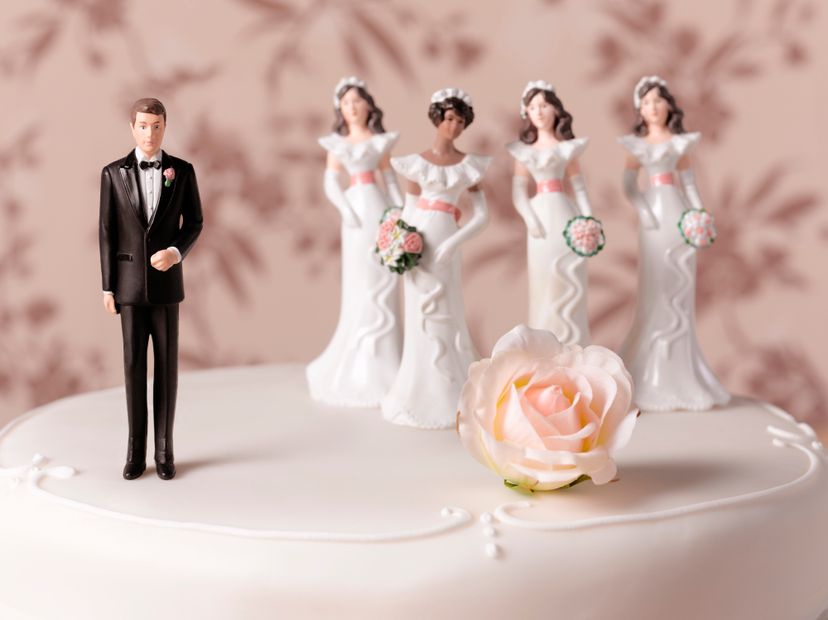
Polygamy typically refers to a relationship where an individual enters into marriage with multiple partners. It is the opposite of monogamy, which involves a committed relationship with one partner.
Advertisement

Polygamy typically refers to a relationship where an individual enters into marriage with multiple partners. It is the opposite of monogamy, which involves a committed relationship with one partner.
Advertisement
There are three primary forms of polygamy: polygyny, polyandry, and group marriage.
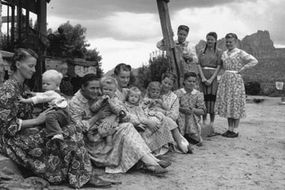
Polygyny is the specific variant of polygamy wherein a man enters into marriages with two or more women.
Advertisement
Often, polygyny is used synonymously with polygamy due to its prevalence as the most common practice of Polygamy. Polygyny, rewards males who have access to greater wealth and resources than others. It takes a lot of work and money to support a large number of wives and the children they produce. In biological terms, such a man is an excellent choice for reproducing and passing his genes on to the next generation, which could be expected to be similarly successful. A man can father many children in a short period, while a woman is limited to one pregnancy every nine months. If a successful man has many wives, he can pass on his genes more often. This is also an advantage in societies where rapid and frequent reproduction is vital for survival.
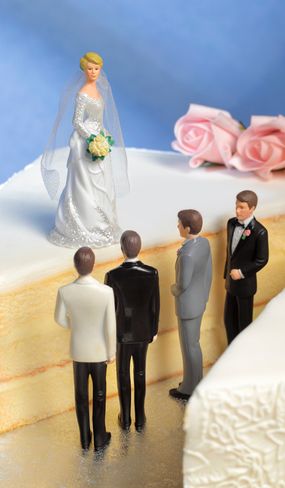
Polyandry represents a less common manifestation of polygamy, wherein a woman takes multiple husbands.
The Nyinba people of Nepal practice fraternal polyandry. In Nyinbian culture, when a woman marries a man, she marries all of his brothers, too. All of the brothers have equal sexual access to the wife, and the entire family cares for the children, although the family may recognize individual brothers as the specific father of a given child [ref]. This kind of marriage structure concentrates the wealth and resources of all the brothers into one family, and also concentrates their parents' land and wealth. This "brotherly love" is known as Fraternal or Adelphic polyandry, derived from the Greek word meaning brother, is a variant of polyandry where a woman is simultaneously wed to two or more men who happen to be brothers.
As the name suggests, group marriage occurs when several men and women marry one another, forming a rarer configuration within the realm of polygamy.
Group marriage, also known as conjoint marriage, offers potential benefits such as enhanced emotional support, shared responsibilities, and a strengthened sense of community. This form of marriage can provide a robust support network where emotional needs are diversified among multiple partners, potentially reducing the burden on any single individual. Additionally, responsibilities like childcare, household chores, and financial obligations can be distributed more evenly, leading to a more balanced and efficient family structure. Group marriages often foster a strong sense of unity and a sense of shared purpose.
Advertisement
Today, most Americans think of monogamy as the "normal" form of marriage. But as it turns out, strictly monogamous practices are in the minority. In fact, cultures that practice some form of polygamy outnumber monogamous cultures by the hundreds [ref]. Some critics suggest that the Western practice of frequent divorce and remarrying represents a form of serial polygamy, though most anthropologists consider it serial monogamy -- no one gets married to more than one person at one time.
Polygamy is as old as the Bible. Abraham and Jacob each had more than one wife. King David had six. King Solomon had 700 (not to mention 300 concubines).
Advertisement
Whether ancient or modern, polygamous or monogamous, marriage has rules. There may be ages and genders to consider. In early America, there were races to consider. Often, those considerations draw on religious beliefs: The Quran allows a man to take up to four wives. In Fundamentalist Mormonism, there is no set limit to the number of wives in one marriage. Joseph Smith, the Mormon Prophet who first delivered God's directive that Mormons practice plural marriage, ultimately took dozens of wives.
At the mention of polygamy, many minds go immediately to Muslims and Mormons. In fact, mainstream Mormons (the Church of Jesus Christ of Latter Day Saints, or LDS) don't practice polygamy; some fundamentalist break-off sects, no longer part of the LDS, do practice it. And Fundamentalist Mormons and Muslims aren't the only ones practicing polygamy. Some Neopagans, including Wiccans, are open to the practice, as are several Liberal Christian groups. And way back in the Bible, Abraham, the first Jew, and his grandson Jacob are reported to have had more than one partner.
The Nyinba people of Nepal practice fraternal polyandry. In Nyinbian culture, when a woman marries a man, she marries all of his brothers, too. All of the brothers have equal sexual access to the wife, and the entire family cares for the children, although the family may recognize individual brothers as the specific father of a given child [ref]. This kind of marriage structure concentrates the wealth and resources of all the brothers into one family, and also concentrates their parents' land and wealth.
Early Jewish doctrine encouraged polygyny because Jews were a minority and needed to increase their numbers rapidly. Some orthodox Jewish sects advocate polygyny today, and some scholars believe that the Talmud contains passages suggesting tolerance or even encouragement of polygyny.
Islamic tradition addresses polygamy directly. The Koran states that a man is allowed up to four wives, but only if he can support them and treat them all equally. Many Islamic societies continue to allow polygamy, but usually only the most affluent men can afford multiple wives. Westernization has led many younger Muslims to view polygamy as old-fashioned.
In Vietnam, polygamy is not legal, but there's a practical reason for its practice -- decades of war has left the male population severely depleted. Polygamy was also common in China before Confucianism, which supported the practice, fell out of favor. Many African tribes, Native American tribes and pre-Christian Celts practiced polygamy, often without the conservative restraints on the sexual aspects of it that characterize Mormon polygamy [ref].
Advertisement
Polygamy, is legal nowhere in North America, underscoring the depth of conviction held by the select few who practice it anyway.
In the United States, Fundamentalist Mormons are the most common groups to practice polygamy (although some Neopagans, Liberal Christians and some others also do). For Mormons, polygamy is the Divine Principle, reflecting God's wish that his people are "fruitful and multiply." Mainstream Mormons, members of the Church of Jesus Christ of Latter Day Saints (LDS), officially stopped practicing the Principle in the late 1800s. Those who continued forming polygamous relationships were eventually excommunicated and became the Fundamentalist Mormons, which include various sects including the FLDS, the AUB, the Priesthood Work and the Independent Fundamentalists not associated with any particular group.
Advertisement
Most polygamists in North America, are practicing plural marriage as the Divine Principle, a component of the Mormon belief system. It was made very public, perhaps for the first time, in the HBO series "Big Love" or the TLC reality show "Sister Wives." The Divine Principle is still on the books in the LDS Church, but its practice has been discontinued. Mormons who refused to give it up were ultimately excommunicated from the LDS.
Estimates have their numbers at somewhere between 30,000 and 50,000 in North America, most living in small communities in parts of the Western United States.
Polygamy is something of a mystery to most people living outside those communities. Outsiders are typically offered only a partial glimpse, and then it's in the context of a "raid" like the one that resulted in the arrest of Prophet Warren Jeffs, the removal of hundreds of children from their multiple mothers, and those rare photos of rural women wearing identical prairie dresses.
This is not, of course, the full picture of Fundamentalist Mormon polygamy. It's barely a sketch. For one thing, what's the Principle really about? When did it begin, how has it been practiced, and how, if polygamy is illegal, are tens of thousands of people marrying more than one spouse?
It starts with a man named Joseph Smith, who had a revelation.
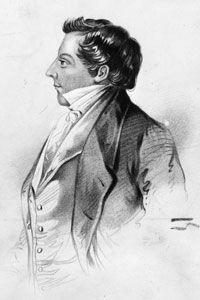
In the 1800s, "Mormon" meant one thing: the Church of Jesus Christ of Latter Day Saints. In 1831, the head of the LDS -- the Prophet -- was Joseph Smith, and he believed God had ordered him to spread the practice of polygamy among his people.
Specifically, God revealed to Smith that Mormons were to practice polygany, which is the marriage of one man to multiple wives.
The revelation was based on a simple principle: God wanted his people to multiply. Men can produce any number of offspring at one time, while women can only bear about one child per year. A marriage between a single man and multiple women would therefore bear a greater number of offspring than one between a single man and a single woman.
The Mormon Church refers back to God's directive in Genesis 1:28, "be fruitful, and multiply, and replenish the earth," for polygamy's ancient roots. Joseph Smith's revelation, the Divine Principle, is reflected in several passages of the Mormon scripture Doctrine and Covenants, including:
It's not all about multiplying, though. Smith and his followers also believed that plural marriage expanded the mind and the heart, encouraged patience, tested one's faith, and helped steer the righteous away from the sins of adultery and envy.
Still, in the aftermath of Joseph Smith's revelation, Mormons were faced with a difficult transition.
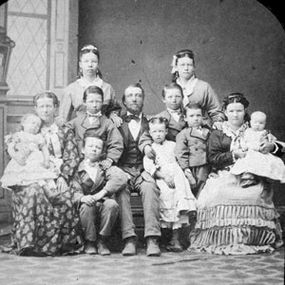
Polygamy was slow to spread throughout the Church, taking years to catch on. It was not an easy directive to accept. For one thing, plural marriage was, and still is, illegal all over North America; accepting Smith's revelation made Mormons outlaws (although the principle of religious freedom often protected them from government interference, at least in the beginning).
Plus, in a group of devout people who had always practiced monogamy, a directive for a man to have sex with more than one woman was a tough sell.
But within a couple of generations, Smith's example (he ultimately married dozens of women, some quite young) became, if not the norm, then at least pretty normal. Enough people engaged in polygamy that it became a core practice within the Mormon belief system.
That lasted for about 60 years. The Divine Principle is still in the Mormon scripture and is still respected by the LDS Church, but the practice is not. In 1889, then-President and Prophet Wilford Woodruff received a revelation stating that the time for polygamy (and the outlaw Mormon) had passed.
The next year, the LDS issued a decree that there would be no new plural marriages in the Church, and in the early 1900s, the Mormon leadership began to excommunicate those Mormons still forming new polygamous unions. Those excommunicated Mormons became the Fundamentalist sects that still engage in polygamy today.
This is an important distinction to make. The differences between LDS Mormons and Fundamentalist Mormons go beyond mere labels.
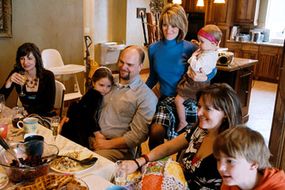
By various estimates and definitions, there are anywhere from five to more than a dozen different sects within the Fundamentalist Mormon community, each with its own Prophet and living space. At one point, they were all one group of Mormons excommunicated for maintaining a polygamous lifestyle, and many of the break-off sects are still connected financially in one way or another, sometimes via land rights or corporations.
Fundamentalist Mormons are spread out around the American West and in parts of Mexico and Canada. Their numbers are hard to pin down due to the secretive nature of their polygamist lifestyles, but most estimates are between 30,000 and 50,000.
The largest of these sects is the FLDS, or Fundamentalist Church of Jesus Christ of Latter Day Saints (primarily in Arizona and Utah). With about 10,000 members, it comprises perhaps 25 percent of Fundamentalist Mormons. The next largest is the AUB, or Apostolic United Brethren, also known as the Allred Group (primarily in Utah). Its numbers are in the area of 7,500.
Other, smaller sects have anywhere from a hundred to about 1,500 members. They include the Centennial Park Group (Arizona), the Davis County Cooperative Society (Utah), the Church of the Firstborn (Mexico), the Bountiful Groups (Canada), the Confederate Nations of Israel (Utah), the True and Living Church of Jesus Christ of Saints of the Last Days (Utah), and the Missouri Community (Mormons settled in Missouri after Joseph Smith revealed the Second Coming would take place there).
While it's true that some of the wives in polygamous marriages receive government support (only the first wife is legally married -- the others are single mothers), Fundamental Mormons also run farms and have construction companies. They work on construction projects -- legitimate ones -- all over the West and Mexico, and, with a few exceptions, interact with those outside their sects. In most cases, the people they work with outside their communities simply look the other way on the polygamy issue. It's illegal, but in many areas, particularly in Utah, outsiders practice a certain degree of lenience toward the religiously sanctioned plural marriages.
Polygamy, while invariably illegal throughout North America, is still a form of marriage. As such, there are guidelines regarding the way Fundamentalist Mormons form their commitments and carry them out. Perhaps the most basic one is this: Only a specific form of polygamy is sanctioned.
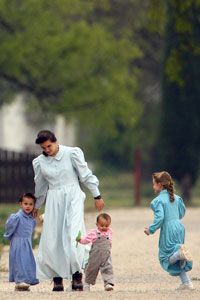
To those on the outside, Fundamentalist Mormon polygamy may look like a free-for-all, all those women and children, and children holding younger children. In fact, there are rules guiding polygamy just like there are with any other type of marriage. There's no "Polygamy Rule Book" to refer to -- these are outlaw societies, after all -- but some of the guidelines are clear.
Fundamentalist Mormons are not simply polygamous. Polygamy means "plural marriage" and includes polyandry, between one woman and multiple men; group marriage, between more than one woman and more than one man; and polygany (with an "n"), between one man and multiple women. The latter is the most common type of plural marriage in the world, and it's the one Fundamentalist Mormons practice. There are no polyandrous or group marriages in these communities.
Each Fundamentalist group has a Prophet, and that Prophet, as God's messenger, grants the right to marry. In most sects, members will ask his permission to form a marriage, and he will allow it or not.
In the FLDS, which is the Warren Jeffs Community, it is believed that Jeffs actively arranged marriages, placing women (or, as is charged, young girls) with husbands according to God's determination.
In order to be worthy of marriage and family, a man and his wives must be in good standing with God. Prophets have the power to "reassign" a man's wives and children if that man is deemed unrighteous. This is believed to be a rare occurrence in most sects.
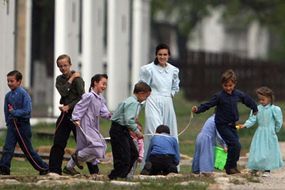
The Divine Principle begins with fruitfulness. Having many children is at the core of the practice, and men and women are expected to multiply. The more wives a man has, the more children he will father.
While there certainly are differences between the various sects in the details, it is within these basic guidelines that Fundamentalist Mormons practice polygamy. It's ordered by God, guided by the prophet, and for the overarching purpose of producing children.
Although, most of those practicing the principle will tell you that it is also, as much as any other marriage, about love.
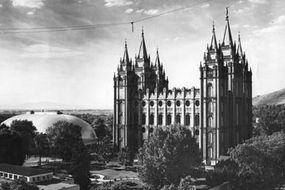
Not all Fundamentalist Mormon groups are alike -- there are anywhere from five to more than a dozen separate Fundamentalist sects out there, depending on how you define "separate," and each has its own Prophet, location, name and customs. While they all tend to live in tight communities, dress conservatively and practice polygamy, there are profound differences between them, too.
Many people have come to associate Mormon Fundamentalism with media images and information released after raids on polygamist compounds: child brides, women and girls who look like they stepped out of 1920s rural America, and fully isolated lives.
Many of those images are of the FLDS, or Fundamentalist Church of Latter Day Saints (which is not affiliated with the mainstream LDS Church). A lot of Fundamentalist Mormons in fact live more open, "normal" lives. They have ties to the community, dress conservatively but in today's styles, and have modern hair styles. They get married when they want to and they choose their own spouses.
In the end, of course, the practice of polygamy sets all Fundamentalist Mormons apart from the monogamous majority. In areas where they've settled en masse, though, polygamists tend to find a relatively laissez faire attitude on the part of government agencies and neighbors, their religious choice tolerated unless it impinges on other rights. A marriage involving three consenting adults, for instance, may skate by under "religious freedom." One between two consenting adults and a 14-year-old child would draw the cops if the truth got out.
But most Fundamentalist Mormons don't form marriages that include children. Most are, polygamy aside, law-abiding citizens who either contribute to the community or else live quietly outside it, and most of the monogamous relationships surrounding them adopt a live and let live attitude.
Nonetheless, the division is deep: Most people don't marry two, three or 10 spouses, and the taboo seems to be an enduring one. As long as a Western marriage is between exactly two people, a certain degree of secrecy, and therefore separation, will be part of the polygamous lifestyle in North America.
Advertisement
Polygamy is now illegal in the United States, China, Australia, the United Kingdom, and the European Union.
Misconceptions about the Mormon religion have become fairly ingrained in modern Western culture. Those who live far from mainstream Mormon communities often confuse Fundamental Mormonism with LDS Mormonism. This is a mistake.
Advertisement
Certainly, the most basic division between LDS Mormons and Fundamentalist Mormons is also the most obvious one: the practice of polygamy. In short, "Big Love" is not the mainstream.
LDS Mormons don't believe in plural marriage. It hasn't been sanctioned by the Church in well over 100 years. Fundamentalist Mormons do practice polygamy (although not every single one -- some believe in the Principle but choose monogamy for themselves). That is, at the core, what makes them "Fundamentalist."
But it's not the only thing. Aside from the polygamous marriage issue, there are key lifestyle differences between LDS and Fundamentalist.
Mainstream Mormons are just that: mainstream. They may live in areas with large Mormon populations, but in much the same way as Muslims, Jews, Catholics, conservatives, liberals, or new immigrants may choose communities of like minds. LDS Mormons work, shop, dine and watch movies right alongside the rest of the general population. They tend to look just like any other conservatively dressed people out there.
And the LDS Prophet is not all-powerful; a council is involved in all Church decisions. That's a key difference: In Fundamentalist Mormon sects, the Prophet is entirely in charge. It's what can make Fundamentalist sects seem cultish to some. But it's important to note that the individual sects are just that: individual…
Advertisement
While polyandry is rare, societies that allow both multiple husbands and multiple wives is even rarer. The Amazon Zoe tribe is a notable example of this practice.
Polygamy is often confused with polyamory and bigamy. Bigamy occurs when one man illegally marries more than one woman. He might marry a second wife before his divorce is complete, for example. In rare cases, men have carried on double lives, marrying two women and supporting two families, with neither wife knowing about the other. Practicing polygamy in a country with laws that forbid it is technically bigamy.
Advertisement
Polyamory is the concept of being in love with more than one person at one time. Polygamists practice polyamory, but polyamorists don't necessarily practice polygamy. They may have living arrangements in which multiple adults form one family, share economic burdens, care for children and share sexual access with one another. However, they do not usually attempt to form a legal marriage. The line between a polyamorous family and a polygamist family is a fine one. Although broad generalizations always have exceptions, polyamorists tend to have communal, liberal views, while polygamists generally come from conservative religious backgrounds.
Swingers are married people who openly engage in sex with people other than their spouses. They don't generally form lasting relationships beyond friendships, nor do they form family structures: the focus is on sexual relationships alone.
Advertisement
One potential advantage is the pooling of resources and support within a polygamous household. With multiple adults contributing to the family's economic well-being, there's often a higher combined income, which can lead to better financial stability. This can, in turn, facilitate meeting essential needs such as education, healthcare, and housing for the entire household.
Another benefit can be seen in the expanded support network within polygamous families. With multiple adults involved, there is a larger pool of caregivers available to nurture and care for children, reducing the caregiving burden on any one individual. This can enhance the emotional well-being of both children and adults, as they have a wider circle of family members to rely on for social and emotional support. In fact, a 2015 study in Tanzania suggested that polygamous families might bring certain health and economic benefits to women and children. However, it's important to note that this was a small study, and the advantages observed may not apply universally.
Advertisement
Polygamy, as we can see from its popularity in early civilizations and primative communities, was often seen as helpful for multiple reasons. In agrarian societies, it facilitated economic stability by providing larger families with multiple spouses and children who could contribute to agricultural labor, increasing food production and overall economic well-being. Additionally, in societies lacking extensive social welfare systems, polygamy acted as a social safety net, with multiple spouses and their extended families offering support during times of adversity, such as crop failures or natural disasters. Furthermore, in regions with high mortality rates due to factors like warfare and diseases, polygamy contributed to population growth by allowing more women to bear children, particularly vital for communities facing threats to survival.
Polygamy, particularly polygyny where one man has multiple wives, presents several potential pitfalls.
One significant concern is the power imbalance it often creates between men and women in these relationships, leading to competition among women for men's attention. Studies have shown that women in polygynous relationships are more likely to suffer from mental health issues, including higher levels of anxiety, depression, and decreased life and marital satisfaction. Additionally, polygamy has been associated with physical, emotional, and sexual abuse, and mothers in such families often experience negative emotions.
The United Nations Human Rights Committee's stated: "polygamy violates the dignity of women,” promote it to “be definitely abolished wherever it continues to exist.”
In a world of overpopulation causing issues for the planet the benefit of larger family sizes in the past are no longer advantageous. Population growth, can strain natural resources and contribute to overpopulation, deforestation, habitat destruction, climate change with emissions, and other environmental challenges.
One of the disadvantages of polygamy occurs when the breadwinner, typically the husband in polygynous arrangements, cannot generate sufficient income to adequately support multiple wives and their respective families. This financial strain can lead to significant hardships, including poverty, dependency on external assistance, intra-family conflicts, and inadequate care for children. Such situations can create a cycle of economic instability within the polygamous household, making it challenging for families to achieve financial security and placing the well-being of family members, particularly women and children, at risk due to limited access to essential resources and opportunities.
• Enos, Lisa, director. "A&E Investigative Reports: Inside Polygamy." August 14, 2001.
• Gray, Patrick J., editor. "Ethnographic Atlas Codebook." World Cultures 1998 10(1):86-136.
• Ross, Rick. "A brief history of the polygamists in Colorado City, Arizona and Hildale, Utah." April 5, 2002. http://www.rickross.com/reference/polygamy/polygamy4.html
• Schultz, Emily A. & Lavenda, Robert H. "Cultural Anthropology." Oxford University Press, August 5, 2004. ISBN 0195170113.
• Tanner, Sandra & Tanner, Jerald. "Covering Up Mormon Polygamy." Salt Lake City Messenger, August 1998.
• Tracy, Kathleen. "The Secret Story of Polygamy." Sourcebooks, December 2001. ISBN 1570717230.
• Llewellyn, John R. "Polygamy Under Attach -- From Tom Green to Brian David Mitchell." Utah Books.http://utahbooks.com/Polygamy_Groups.htm
• Wilde, Anne. "Fundamentalist Mormonism: Its History, Diversity and Stereotypes." Principle Voices.http://principlevoices.org/about/board-of-directors/remarks-papers-by-anne-wilde/paper-fundamentalist-mormonism-its-history-diversity-and-stereotypes
• Winston, Kimberly. "Analysis: Fundamentalist Mormons stress polygamy above all." USA Today. May 30, 2008.http://www.usatoday.com/news/religion/2008-04-17-polygamist-mormon-sect_N.htm
• Introduction to plural marriage: polygamy, polygyny & polyandry. ReligiousTolerance.org.http://www.religioustolerance.org/polyintro.htm
• Polygamy in America. Public Radio International. February 10, 2010.http://www.pri.org/politics-society/polygamy-in-america1873.html
• Polygamy (Plural Marriage). The Church of Jesus Christ of Latter-Day Saints.http://www.lds.org/ldsorg/v/index.jsp?locale=0&sourceId=9887ec6f164b2110VgnVCM100000176f620a____&vgnextoid=bbd508f54922d010VgnVCM1000004d82620aRCRD
• Woods, Daniel. "Bountiful, B.C." Rick Ross. August 4, 2001.http://www.rickross.com/reference/polygamy/polygamy65.html
• Zoellner, Tom. "Polygamy: The Guiding Principle." Salt Lake Tribune. June 28, 1998.http://www.rickross.com/reference/polygamy/polygamy6.html
Advertisement
Please copy/paste the following text to properly cite this HowStuffWorks.com article:
Advertisement